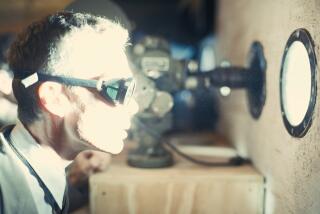Kerry makes ‘gut-wrenching’ visit to Hiroshima memorial
- Share via
Reporting from HIROSHIMA, Japan — An emotional John Kerry said Monday that Hiroshima’s horrible history should teach humanity to avoid conflict and strive to eradicate nuclear weapons as he became the first U.S. secretary of State to tread upon the ground of the world’s first atomic bombing.
Kerry’s visit to the Japanese city included a tour of its peace museum with other foreign ministers of the Group of Seven industrialized nations and a ceremony to lay a wreath at the adjoining park’s stone-arched monument, with the exposed steel beams of Hiroshima’s iconic A-Bomb Dome in the distance.
The U.S. attack on Hiroshima in the final days of World War II killed 140,000 people and scarred a generation of Japanese, while thrusting the world into the Atomic Age. But Kerry said he hoped his trip would underscore how Washington and Tokyo have forged a deep alliance over the last 71 years and how everyone must ensure that nuclear arms are never used again.
“While we will revisit the past and honor those who perished, this trip is not about the past,” he told Japanese Foreign Minister Fumio Kishida, a Hiroshima native. “It’s about the present and the future particularly, and the strength of the relationship that we have built, the friendship that we share, the strength of our alliance and the strong reminder of the imperative we all have to work for peace for peoples everywhere.”
Kerry’s appearance, just footsteps away from ground zero, completed an evolution for the United States, whose leaders avoided the city for many years because of political sensitivities.
No serving U.S. president has visited the site, and it took 65 years for a U.S. ambassador to attend Hiroshima’s annual memorial service. Many Americans believe that the dropping of atomic bombs here on Aug. 6, 1945, and on the Japanese city of Nagasaki three days later were justified and hastened the end of the war.
See more of our top stories on Facebook >>
Kerry didn’t speak publicly at the ceremony, though he could be seen with his arm around Kishida and whispering in his ear.
The otherwise somber occasion was lifted by the presence of about 800 Japanese schoolchildren waving flags of the G-7 nations, including that of the United States. They cheered as the ministers departed with origami cranes in their national colors around their necks. Kerry was draped in red, white and blue.
Hours afterward, the top American diplomat still seemed to be absorbing all that he saw.
It reminds everybody of the extraordinary complexity of choices of war and what war does to people, to communities, countries, the world.
— John Kerry
“It is a stunning display, it is a gut-wrenching display,” he told reporters of the museum tour, recounting exhibits that showed the bomb, the explosion, the “incredible inferno” and mushroom cloud that enveloped Hiroshima. “It tugs at all of your sensibilities as a human being. It reminds everybody of the extraordinary complexity of choices of war and what war does to people, to communities, countries, the world.”
Kerry urged all world leaders to visit, saying: “I don’t see how anyone could forget the images, the evidence, the re-creations of what happened.”
Japanese survivors groups have campaigned for decades to bring leaders from the U.S. and other nuclear powers to see Hiroshima’s scars as part of a grass-roots movement to abolish nuclear weapons.
As Kerry expressed interest, neither Japanese government officials nor survivor groups pressed for the U.S. to apologize.
“I don’t think it is something absolutely necessary when we think of the future of the world and peace for our next generation,” Masahiro Arimai, a 71-year-old Hiroshima restaurant owner, said of an apology.
Yoshifumi Sasaki, a 68-year-old, longtime resident, agreed: “We all want understanding.”
Both wished for President Obama to follow in Kerry’s footsteps next month.
The president still hasn’t made a decision about visiting Hiroshima and its memorial when he attends a Group of Seven meeting in central Japan in late May. During his first year in office, Obama said he would be “honored” to make such a trip.
“Everyone in the world should see and feel the power of this memorial,” Kerry wrote in the museum’s guest book. “It is a stark, harsh, compelling reminder not only of our obligation to end the threat of nuclear weapons, but to rededicate all our effort to avoid war itself.”
“War must be the last resort -- never the first choice,” he added.
Wading into U.S. politics, Kerry and his Japanese counterpart rejected Republican presidential candidate Donald Trump’s recent suggestion that Japan consider developing its own nuclear weapons to defend itself against nuclear-armed North Korea.
Kishida said, “For us to attain nuclear weapons is completely inconceivable.”
Kerry called such notions “absurd on their face,” contradicting the efforts of every Democratic and Republican president since World War II to prevent wider nuclear proliferation.
Kerry acknowledged that some governments want all nuclear weapons, including those in the U.S. arsenal, destroyed immediately. He described such calls as unrealistic, potentially making the world more dangerous in the short term by ridding nations of their deterrence against bad actors such as North Korea. Instead, he urged an ordered, methodical process toward the final goal of denuclearization.
“We all know it’s not going to happen overnight,” Kerry said.
But he said, “We have to get there.”
ALSO
In Mumbai, the horse-and-carriage days are numbered
Ukraine’s embattled prime minister resigns as corruption scandals shake Europe
Keiko Fujimori looks like a winner in the first round of Peru’s presidential election
More to Read
Sign up for Essential California
The most important California stories and recommendations in your inbox every morning.
You may occasionally receive promotional content from the Los Angeles Times.










